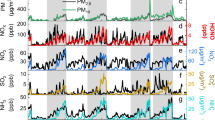Abstract
The air quality model CMAQ-MADRID (Community Multiscale Air Quality-Model of Aerosol Dynamics, Reaction, Ionization and Dissolution) was employed to simulate summer O3 formation in Beijing China, in order to explore the impacts of four heterogeneous reactions on O3 formation in an urban area. The results showed that the impacts were obvious and exhibited the characteristics of a typical response of a VOC-limited regime in the urban area. For the four heterogeneous reactions considered, the NO2 and HO2 heterogeneous reactions have the most severe impacts on O3 formation. During the O3 formation period, the NO2 heterogeneous reaction increased new radical creation by 30%, raising the atmospheric activity as more NO→NO2 conversion occurred, thus causing the O3 to rise. The increase of O3 peak concentration reached a maximum value of 67 ppb in the urban area. In the morning hours, high NO titration reduced the effect of the photolysis of HONO, which was produced heterogeneously at night in the surface layer. The NO2 heterogeneous reaction in the daytime is likely one of the major reasons causing the O3 increase in the Beijing urban area. The HO2 heterogeneous reaction accelerated radical termination, resulting in a decrease of the radical concentration by 44% at the most. O3 peak concentration decreased by a maximum amount of 24 ppb in the urban area. The simulation results were improved when the heterogeneous reactions were included, with the O3 and HONO model results close to the observations.
Similar content being viewed by others
References
Bowman, F. M., and J. H. Seinfeld, 1994: Ozone productivity of atmospheric organics. J. Geophys. Res., 99, 5309–5324.
Byun, D. W., and J. K. S. Ching, Eds., 1999: Science algorithms of the EPA Models-3 community multi-scale air quality (CMAQ) modeling system. Rep. EPA-600/R-99/030, National Exposure Research Laboratory, Research Triangle Park, N.C., Chapter 1, 18pp.
Calvert, J. G., G. Yarwood, and A. M. Dunker, 1994: An evaluation of the mechanism of nitrous acid formation in the urban atmosphere. Research on Chemical Intermediates, 20, 463–502.
Dentener, F., G. R. Carmichael, Y. Zhang, J. Lelieveld, and P. J. Crutzen, 1996: Role of mineral aerosol as reactive surface in the global troposphere. J. Geophys. Res., 101(D17), 22869–22889.
Dickerson, R. R., S. Kondragunta, G. Stenchikov, K. L. Civerolo, B. G. Doddridge, and B. N. Holben, 1997: The impacts of aerosols on solar ultraviolet radiation and photochemical smog. Science, 278, 827–830.
Gery, M. W., G. Z. Whitten, J. P. Killus, and M. C. Dodge, 1989: A photochemical kinetics mechanism for urban and regional scale computer modeling. J. Geophys. Res., 94, 12,925–12,956.
Grell, G. A., J. Dudhia, and D. R. Stanffer, 1994: A description of the Fifth-generation Penn State/NCAR Mesoscale Model (MM5). NCAR Tech. Note, NCAR/TN-398 + STR, 138pp.
Guenther, A., and Coauthors, 1995: A global model of natural volatile organic compound emissions. J. Geophys. Res., 100, 8873–8892.
Harris, G. W., W. P. L. Carter, A. M. Winer, J. N. Pitts, U. Platt, and D. Perner, 1982: Observations of nitrous acid in the Los Angeles atmosphere and implications for the predictions of ozone-precursor relationships. Environ. Sci. Technol., 16, 414–419.
Harrison, R. M., J. D. Peak, and G. M. Collins, 1996: Tropospheric cycle of nitrous acid. J. Geophys. Res., 101, 14429–14439.
Horowitz, L. W., J. Liang, G. M. Gardner, and D. J. Jacob, 1998: Export of reactive nitrogen from North America during summertime: Sensitivity to hydrocarbon chemistry. J. Geophys. Res., 103(D11), 13451–13476.
Jacob, D., 2000: Heterogeneous chemistry and tropospheric ozone. Atmos. Environ., 34, 2132–2159.
Jeffries, H. E., and S. Tonnesen, 1994: A comparison of two photochemical reaction mechanisms using mass balance and process analysis. Atmos. Environ., 28(18), 2991–3003.
Nenes, A., S. N. Pandis, and C. Pilinis, 1998: ISOR-ROPIA: A new thermodynamic model for inorganic multicomponent atmospheric aerosols. Aquatic Geochemistry, 4, 123–152.
Ravishankara, A. R., 1997: Heterogeneous and multiphase chemistry in the troposphere. Science, 276, 1058–1065.
Riemer, N., H. Vogel, B. Vogel, B. Schell, I. Ackermann, C. Kessler, and H. Hass, 2003: Impact of the heterogeneors hydrolysis of N2O5 on chemistry and nitrate aerosol formation in the lower troposphere under photosmog conditions. J. Geophys. Res., 108(D4), 4144, doi: 10.1029/2002JD002436.
Sillman, S., 1995: The use of NOY, H2O2, and HNO3 as indicators for ozone-NOx-hydrocarbon sensitivity in urban locations. J. Geophys. Res., 100(D7), 14175–14188.
Streets, D. G., and Coauthors, 2003: An inventory of gaseous and primary aerosol emissions in Asia in the year 2000. J. Geophys. Res., 108(D21), 8809, doi: 10.1029/2002JD003093.
Tang, Y., and Coauthors, 2003: The impacts of dust on regional tropospheric chemistry during the ACE-ASIA experiment: A model study with observations. J. Geophys. Res., 108(D21), doi: 10.1029/2003JD03506.
Wang, Z., H., H. Ueda, and M. Huang, 2000: A deflation module for use in modeling long-range transport of yellow sand over East Asia. J. Geophys. Res., 105(D22), 26947–26959.
Wang Xuesong, 2002: A numerical simulation study on ozone and secondary aerosol in Regional atmosphere. Ph.D dissertation, College of Environmental Sciences, Peking University, Beijing. (in Chinese)
Wang Xuesong, and Li Jinlong, 2003: A case study of ozone source apportionment in Beijing. Acta Scientiarum Naturalium Universitatis Pekinensis, 39(2), 244–253. (in Chinese)
Yu Jiahua, G. Benjamin, Yu Tong, Wang Xin, and Liu Wenqing, 2005: Seasonal variations of number size distributions and mass concentrations of atmospheric particles in Beijing. Adv. Atmos. Sci., 22(3), 401–407.
Zhang, Y., and Coauthors, 2004: Development and application of the Model of Aerosol Dynamics, Reaction, Ionization and Dissolution (MADRID). J. Geophys. Res., 109, D01202, doi: 10.1029/2003JD003501.
Zhang Yuanhang, Shao Kesheng, Tang Xiaoyan and Li Jinlong, 1998: The study of urban photochemical smog pollution in China. Acta Scientiarum Naturalium Universitatis Pekinensis, 34(2–1), 392–400. (in Chinese)
Author information
Authors and Affiliations
Rights and permissions
About this article
Cite this article
Xu, J., Zhang, Y. & Wang, W. Numerical study on the impacts of heterogeneous reactions on ozone formation in the Beijing urban area. Adv. Atmos. Sci. 23, 605–614 (2006). https://doi.org/10.1007/s00376-006-0605-1
Received:
Revised:
Issue Date:
DOI: https://doi.org/10.1007/s00376-006-0605-1




